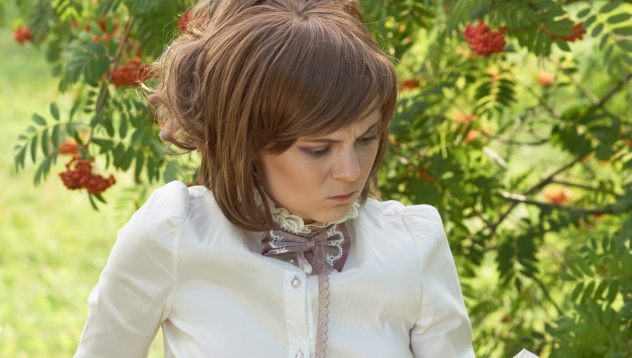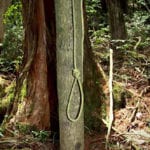 Weird Stuff
Weird Stuff  Weird Stuff
Weird Stuff  Politics
Politics 10 Political Scandals That Sent Crowds Into the Streets
 Weird Stuff
Weird Stuff Ten Bizarre Facts About The Doge Meme
 Our World
Our World 10 Ways Your Christmas Tree Is More Lit Than You Think
 Movies and TV
Movies and TV The 10 Coolest Stars to Set Sail on The Love Boat
 History
History 10 Things You Didn’t Know About the American National Anthem
 Technology
Technology Top 10 Everyday Tech Buzzwords That Hide a Darker Past
 Humans
Humans 10 Everyday Human Behaviors That Are Actually Survival Instincts
 Animals
Animals 10 Animals That Humiliated and Harmed Historical Leaders
 History
History 10 Most Influential Protests in Modern History
 Weird Stuff
Weird Stuff 10 Funny Ways That Researchers Overthink Christmas
 Politics
Politics 10 Political Scandals That Sent Crowds Into the Streets
 Weird Stuff
Weird Stuff Ten Bizarre Facts About The Doge Meme
Who's Behind Listverse?

Jamie Frater
Head Editor
Jamie founded Listverse due to an insatiable desire to share fascinating, obscure, and bizarre facts. He has been a guest speaker on numerous national radio and television stations and is a five time published author.
More About Us Our World
Our World 10 Ways Your Christmas Tree Is More Lit Than You Think
 Movies and TV
Movies and TV The 10 Coolest Stars to Set Sail on The Love Boat
 History
History 10 Things You Didn’t Know About the American National Anthem
 Technology
Technology Top 10 Everyday Tech Buzzwords That Hide a Darker Past
 Humans
Humans 10 Everyday Human Behaviors That Are Actually Survival Instincts
 Animals
Animals 10 Animals That Humiliated and Harmed Historical Leaders
 History
History 10 Most Influential Protests in Modern History
10 Strange Stories From The Life Of P.T. Barnum
Mention P.T. Barnum, and most people will think of showmanship, the circus, and the absolutely inhumane exploitation of people like Joice Heth. While it’s easy to argue that he lived in a different time, it’s undeniable that Barnum did some pretty horrible things, all to line his own pockets. Even in his day, he was loved by some and hated by others. Behind the showman’s facade, there was a fascinating—yet still rather horrible—person.
10 Con Man Or Philanthropist?

Many things have been said about P.T. Barnum. A quote that is frequently attributed to him states, “There’s a sucker born every minute.” This pretty much sums up the attitude that most people associate with him. (The quote is alternately said to have been uttered by a man named David Hannum about Barnum’s involvement with the Cardiff Giant, although some research into that shows that, too, might be false.) Barnum was seen as always looking for the next big con, doing whatever he could to swindle the public and get the paying masses through his doors.
However, according to historians reviewing a cache of Barnum’s letters, that’s not how he saw himself at all. Author and historian Arthur Saxon has collected more than 3,000 of Barnum’s letters and says that quite contrary to popular opinion of him, Barnum believed that he was providing a public service. He was offering the public a good laugh and a day out at an affordable price. He believed that when people saw that they might have possibly been conned, they would appreciate the joke for what it was and be amused. Saxon also says that he viewed his patrons with the highest regard.
According to Saxon, many of Barnum’s actions were simply misunderstood. One thoughtlessly callous enterprise of which Barnum was accused involved getting permission to dig up the Division Street Cemetery in Bridgeport, Connecticut, move the bodies, and then turn the land into building sites. Saxon argues that he didn’t do this solely for monetary gain. Pigs were already digging up the cemetery, and he had a chance to do some good.
In Barnum’s book, The Humbugs of the World, he clearly separated himself from the real charlatans. They were the butchers who sold mystery meat sausages, the estate agents who sold things that didn’t exist, and the stock brokers who told their clients that their stock was worthless, only to buy it for themselves. Those were the real humbugs, Barnum said—not him.
9 The Temperance Movement

When he wasn’t exhibiting senior citizens billed as the nursemaid to George Washington, Barnum was an outspoken supporter of a handful of surprising causes, including the temperance movement. The strict anti-alcohol movement had a whole series of bizarre claims, and Barnum was convinced that banning alcohol was going to make the world a better place. Until he was about 40 years old, Barnum was quite accustomed to partaking of alcoholic beverages of all kinds. When he started to realize just how common drunkenness was among the upper echelons of society, he started gradually cutting it out of his life, first whiskey, then wine. Finally, when he heard of the temperance movement’s belief that moderate drinkers were just as damning to society as heavy ones, he had his stockpile of champagne destroyed and swore off alcohol completely.
At one point in his career, Barnum even took to the lecture circuit to deliver a series of talks on the evils of alcohol, and when he was elected as mayor of Bridgeport, Connecticut, he chaired the Committee of Temperance and based his political career in part on the idea that it was everyone’s duty to combat the ever-rising tide of alcoholism. After signing his tee-totaling pledge, Barnum wrote, “Our watchword now was, ‘Prohibition!’ We had become convinced that it was a matter of life and death; that we must kill Alcohol, or Alcohol would kill us, or our friends.”
8 Barnum On ‘Negro Suffrage’

In 1865, the 14th Amendment was ratified by Connecticut, not only outlawing slavery, but bringing up some other questions about just what it meant to be a citizen and what rights went along with that—like the right to vote. In this case, Barnum decided to use his talents as a showman and a speaker to campaign in support of awarding freed slaves (who were deemed literate and of good moral character) the right to vote.
Barnum based his stance on the idea that ignorance operated in direct opposition to the ideas of liberty, justice, and freedom for all, which were supported by the constitutional amendments. Getting rid of illiteracy and ignorance is all well and good, but Barnum’s arguments went down a road that, when viewed today, looks incredibly bizarre.
He pointed to the gentle nature of the poor black man, living a religious life and an existence with no desire for revenge. Proof of that was the fact that so many slaves didn’t revolt during the war, kill their masters, or rise up in open rebellion. He added that neither the Irish, the Chinese, the Portuguese, nor any other white man would have shown such a response. Clearly, the newly freed slaves were of a moral character that could benefit from education. Barnum said, “We must educate and Christianize those who are now by circumstances our social inferiors.” He also pointed out that he had once been terrified of the influx of immigrants entering the country, but that ended up mostly all right, because even their political candidates had been trained not to “exhibit his genius by tapping an opponents head with a shillelagh.”
At a glance, odd statements like the one above might simply seem to reflect the attitudes of the day, but there are also rumors that Barnum was pro-slavery. He made no secret of the fact that he had purchased his own slave and wasn’t above having him whipped for transgressions. He also once wrote that if slaves were ever freed, they would run mad, looting and killing as they went. In the 1840s, he gave a few pro-slavery talks in Europe. He also claimed in 1865 that African Americans “have nay more of manhood or womanhood than so many orang-outangs or gorillas.”
7 The Moral Lecture Room

In addition to his freak shows and circus acts, Barnum was also a pioneer in theater. In the 1850s, Barnum opened a 3,000-seat theater called the Moral Lecture Room. Included as part of his museum, the theater was meant to showcase family-oriented moral plays. While outside, people would see things that would shock and disgust, his moral theaters were places that families could bring their children and be assured that they would get nothing but lessons on being good, decent people.
He staged shows like the temperance-oriented The Drunkard, as well as Uncle Tom’s Cabin. At the same time he was catering to middle-class families, he was encouraging some of society’s outsiders to attend the performances. A working-class family might be seated with some of the city’s street gangs, and nearby would be some tourists and a handful of immigrant families. The Moral Lecture Room was exactly that, and when audiences were finished listening to the message on stage, anti-alcohol pledges and other promotional literature were handed out.
However, morality often took a back seat to appealing to the masses. Anti-slavery plays like Uncle Tom’s Cabin were often edited and softened up a bit, so as to not offend any pro-slavery audience members too much. Barnum was well aware that tourists coming into the city might not be as aligned with the abolitionist movement as many Northerners, meaning that when it suited him, his morals could be rather ambivalent.
6 Barnum vs. The ASPCA

Debate has continuously raged between circuses and animal rights groups, which decry the circuses as inhumane, cruel places. That’s nothing new, and Barnum himself went head-to-head with the American Society for the Prevention of Cruelty to Animals (ASPCA) more than once.
In 1866, the president of the society, Henry Bergh, condemned Barnum for his practice of feeding live rabbits to a boa constrictor. Though marketed as entertainment, it was beyond cruel, Bergh said. The slow death of live animals was unnecessary (especially when the terrified animals were left in the snake enclosure for days until the beast got hungry), and Bergh insisted that contrary to the claim that snakes won’t eat dead prey, they would. Otherwise, they should be allowed to starve. (He claimed that this wouldn’t happen.)
Barnum replied with statements from professors that snakes would, in fact, die if not given live prey, as well as the sentiment that he was only giving people what they wanted—seeing animals in their natural state. Weirdly, the letter of support used examples like the fact that no person would ever refuse a lobster salad simply because the creature had been boiled alive and how silly it was to refuse to eat raw oysters because they’re swallowed alive. The debate went back and forth, full of politely worded insults. Public opinion swelled quite massively on the side of Bergh, and in 1867, Barnum ran a newspaper article stating that there was just no pleasing some people.
That wasn’t the end of the story. Oddly enough, Bergh and Barnum ultimately became friends, and Barnum was instrumental in forming a Connecticut branch of the ASPCA.
5 The Fires

When a fire burns down a business, it’s a tragedy. When it happens three times, one might wonder if something else is going on. Today, Barnum is most remembered for his circuses, but it was only after he lost millions of dollars and three museums that he turned to the less permanent circus.
The first fire was a bizarre, somewhat accidental act of war. Confederate spies had been sent to New York City, tasked with setting a series of small fires at the end of 1864. While emergency response teams were busy there, Confederate soldiers were going to free POWs who were being held in the city, loot the treasury, and seize everything they could from the arsenal. They were going to do it with Greek fire; a chemist had made 144 bottles of highly volatile liquid for the plan. Things started going sideways, though, when it came time to go through with the plan, and most of the spies backed out. They regrouped and decided that the remaining people were going to set fire to four hotels each.
Robert Cobb Kennedy had some slightly different ideas, mostly fueled by the alcohol he’d paused to drink. After setting fire to three hotels, he headed for Barnum’s museum and started throwing Greek fire. The museum would suffer the most damage. It was an open area, and although 2,500 people were evacuated, it had something other targets didn’t—oxygen. Before burning hotels, the arsonists closed windows and doors, ultimately helping their fires to burn themselves out.
In July 1865, the museum burned again. The fire started in an engineer’s office and spread quickly, with devastating results. Most of the live animals in the museum died, including two whales that were kept in tanks in the lower levels. They were boiled by the heat. Other animals escaped, and many were never seen again. Barnum had a cache of Revolutionary War artifacts that were also destroyed, but loss of human life was largely avoided thanks to a fireman named William McNamara. The museum’s wax figures caused some confusion among rescuers, including a figure of Jefferson Davis that had been wearing a dress. In truly epic New York fashion, the crowd that had gathered to watch the fire took the opportunity to hang the effigy in front of St. Paul’s Cathedral.
Barnum attempted to reopen his museum nearby, but that, too, burned to the ground. He then turned to a more portable solution, opening what would later be Madison Square Garden. He eventually turned to the idea of a traveling circus.
4 Barnum’s Civil War Exhibitions

Barnum was known for his wild, exotic exhibitions, but during and after the Civil War, he wasn’t above exploiting the public’s fascination with war, either. During the war, he recruited a number of people to take part in his shows and to go on display in his museum, including a 102-year-old American Revolution veteran and an 11-year-old drummer boy. Also on display was Pauline Cushman, the actress who became a spy.
Born in New Orleans, Cushman traveled to New York City to further her career. While on tour with a theater company in Kentucky, she accepted payment to do something that, predictably, got her fired—offer a toast to the Confederate president. Now viewed as a Southern sympathizer, she got her chance to redeem herself in the eyes of the Union when she was offered the chance to spy for the North. Dressing as a camp follower, she was eventually caught stealing battle plans, tried, and sentenced to hang. After a conveniently timed conflict with Union troops, she was freed, given the title of brevet major, and returned to the North.
After the war, she joined up with Barnum and traveled with his circus, sharing stories of her wartime exploits before eventually becoming addicted to opium, which she took for her arthritis. She died of an overdose.
3 Barnum’s Anti-Contraception Law

In 1873, the Comstock laws put an end to the promotion of birth control methods across the country. The laws were passed in hopes of returning a certain sort of morality to the country, and there was another reason for it, too: With more and more women entering the work force, it was feared that they’d put off having children, and the population would plummet. For Barnum, however, the laws weren’t enough.
At the time, he was kicking off a political career as well as one as an entertainer. He spent time in the Connecticut legislature and as the mayor of Bridgeport. He also chaired the Temperance Committee for the House, and it was in that role that he sponsored additional legislation which would ultimately make Connecticut’s contraception laws among the strictest in the country. With Barnum at the head of the movement, Connecticut made it completely illegal to own, use, or sell contraceptives altogether. Anyone found in possession of any kind of birth control would be fined and issued a jail sentence of at least 60 days.
The law stood until 1965, when it was argued in front of the Supreme Court that the law was unconstitutional and violated a couple’s right to marital privacy. The court ruled 7–2 that the law was in outright opposition to personal freedom.
2 The Grand Buffalo Hunt

Barnum also pioneered some pretty creative business tactics, like making money off supposedly “free” events.
In June 1843, Barnum bought a small herd of 15 underfed, docile bison calves with the idea that he was going to find some way to make his $700 investment back, and then some. He took the calves back to Manhattan, figuring that most New Yorkers’ interest in the Wild West was proportionately opposite to how much they actually knew about the West and that he could market the calves as fierce beasts for a rodeo.
He organized his “Grand Buffalo Hunt” to take place August 31, 1843, and set it up in Hoboken, New Jersey. Before he did, though, he made sure that he had secured an interest in the ferries that would be shuttling people from the city to New Jersey, as well as an interest in the concession stands. The show was billed as free to attract as many people as he could, but he would make his money elsewhere.
More than 24,000 New Yorkers made the trip on Barnum’s ferries, and thousands more flooded in from New Jersey. The response was so big that many had to make the ferry trip hanging on the rails. Unsurprisingly, there were a handful of fights, and several people nearly drowned when they were dumped overboard. When they finally got there, the docile, terrified calves were goaded into a stampede that ended in complete chaos when the herd broke through their fence. At least one man was killed when he attempted to climb a tree to get out of the way of the stampede, and the branch broke. Several more were nearly trampled, but people, as a whole, were reportedly pleased with the show. Even though many realized exactly what it was, they also claimed to have appreciated it for what it was. And it was free, after all, and you couldn’t beat that.
Barnum made around $3,500 in profit from his free event. Adjusted for inflation, that’s about $88,000 today.
1 The Irony Of The Barnum Effect

There’s a psychological principle called the Barnum effect, and it explains why some people believe in things like astrology and horoscopes: Make something vague enough, and it can apply to anyone—especially to someone who wants to believe. It’s been found to be created by a combination of things, including a charismatic showman and some basic information about the human condition.
Does that sound familiar? The irony is that Barnum didn’t believe in it; at least, he didn’t believe in spiritualists and mediums. In his book, Humbugs of the World, he wrote an expose on the world of spiritualists and mediums, a world that was doing big business at the time. He wrote about how rapping was done, how they purported to answer questions that were common sense to anyone who was really paying attention, and he debunked practitioners like J.V. Mansfield, who claimed to be able to answer any letter with guidance from the spirit realm, without opening it or looking inside of it.
Barnum even issued a challenge to the spirit mediums of the day. He would write a series of questions to the spirit world and seal the letters in an envelope. Anyone who would correctly answer the questions without touching the envelope would win $500, and Barnum said he would consider it money well spent.
While Barnum himself was well known for exhibiting things like the Fiji Mermaid—things that obviously weren’t what he claimed them to be— he found the idea of fleecing others in the way that spiritualists and palm-readers did to be unthinkable. They were the real humbugs, and as for him: He was just providing some much-needed, much-loved, honest entertainment.








